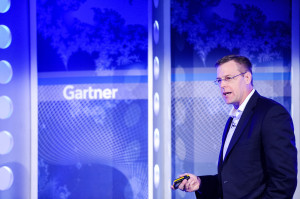Gartner Catalyst Conference 2014: How to Do Business in a Digital World
We attended the Gartner Catalyst Conference in London a few weeks back. We’ve been regulars at the North America event for a few years (here's our recap of 2013), but this was the first full-size Catalyst event to take place in Europe. And with presentations from more Gartner analysts in one place than ever before – four tracks, 16 analysts and 40 sessions to be precise – it was a fantastic inaugural event that we were proud to take part in.
 The event threw out a whole host of interesting topics and discussions, but the one keynote that really did catch our attention was “Architecting the Digital Business: A Blueprint for Competitive Advantage” by Drue Reeves, chief of research for cloud computing within for Gartner for Technical Professionals.
The event threw out a whole host of interesting topics and discussions, but the one keynote that really did catch our attention was “Architecting the Digital Business: A Blueprint for Competitive Advantage” by Drue Reeves, chief of research for cloud computing within for Gartner for Technical Professionals.
Reeves suggested that in today’s digital era, businesses are searching for advice and support on how to use cloud, mobile and analytics to become a “digital business” – certainly a discussion we often find ourselves having with our customers. Take National Geographic and Splunk for example: both organisations recognised the importance of embracing digital technologies, but relied on Okta to understand how best to do so.
Perhaps even more interestingly, Reeves outlined how new technologies and trends, such as cloud, mobile, big data and now the Internet of Things, are reducing barriers to market entry and changing the competitive landscape. A new start-up can become an instant rival to even the most established enterprises, so what can businesses do to survive in this increasingly competitive environment?
To succeed in this new era, businesses need to remain nimble and agile – both in terms of staff and the infrastructure supporting the organisation. People, devices and machines are increasingly connecting in new and different ways. This presents businesses with a number of risks, such as security and visibility concerns, but also a big opportunity in terms of employee engagement and business efficiency. For example, employees are often happier – and more productive – when given choice about which devices and applications they use for work. So while the “safe” approach may be to “lock everything down,” the focus for IT must be on enablement, rather than prevention.
Now’s the time for businesses to start adapting their enterprise architectures to secure and capitalise on the “anywhere, anytime, from any device” opportunity. For CIOs, this means building and securing scalable architectures that encourage collaboration and connectivity, as well as use this data to grow the business and make it more agile and competitive.
CIOs have an opportunity to become heroes by enabling employees to use their device of choice, improving productivity and putting IT at the centre of the businesses success. However, if CIOs continue to bury their heads in the sand, central IT will become irrelevant and competitors will take over. As Reeves suggested, “…organisations that don’t invest in this new architecture will quickly find themselves at a competitive disadvantage.”